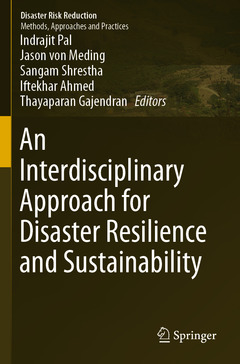An Interdisciplinary Approach for Disaster Resilience and Sustainability, 1st ed. 2020 Coll. Disaster Risk Reduction

Chapter 1: Regional Perspectives on Disaster Resilience and Sustainable Development
Indrajit Pal, Jason Von Meding, Chutinan Klinmalai
Chapter 2: Earthquake Risk Assessment in Momase Region of Papua New Guinea using GIS
Tingneyuc Sekac, Sujoy Kumar Jana, Indrajit Pal andDilip Kumar Pal
Chapter 3: Spatio-Temporal Variability of Landslides in the Sikkim Himalaya, India
Singh, A, Ranjan, R. and Tewari, V.
Chapter 4: Geo Spatial Approach for likelihood damage assessment of buildings due to seismic hazard in urbanized areas
Ganapathy Pattukandan Ganapathy, Saravana Ganesh Manoharan
Chapter 5: Perspective of Science and Technology in Disaster Management and Mitigation
Jogeswari Rout and Kapileswar Mishra
Chapter 6: Application of remote sensing & GIS in flood vulnerability assessment - A case study of Lower Ajay Basin, India
Kartick Chandra Mondal, Sutapa Saha, Pritam Aitch, Gupinath Bhandari
Chapter 7:Stable Isotopes and Groundwater Dynamics of the Shallow Ping River Alluvial System in Kamphaeng Phet Riverbank Filtration (RBF) Prospecting Site, Upper Central Thailand
Nitipon Noipow, Kiattipong Kamdee, Supalak Kongsri, Wutthikrai Kunsawat, Chakrit Saengkorakot, Chunyapuk Kukusamude, Patchariya Chanruang, Ocpasorn Occarach, Arpakorn Wongsit, Vanachawan Hunyek and Wattanapong Montree
Chapter 8:Risk identification, Assessment and Management of a Building Information Modelling (BIM) implemented project
Raju Sarkar, Karan Narang, Prajya Sharma,Indrajit Pal
Chapter 9:Identification of arsenic hazard locations and impact on children – A case study on Baruipur Block, South 24 Parganas, West Bengal
Paramita Chaudhuri, Pritam Aitch, Amit Dutta
Chapter 10: Effect of Changing Vegetation coverage and Metereological Parameters on the Hazard Characteristics of Indian Sundarban Region and its Impact
Papia Guha, Pritam Aitch and Gupinath Bhandari
Chapter 11: The study of the Impact of Wastewater from Outfall in River Ganga, West Bengal on the Growth and Morphological Parameters of Spinacia Oleracea
Sayanti Kar, Indrajit Ghosh, Amitava Ghosh, Pritam Aitch, Gupinath Bhandari
Chapter 12: Modeling of Flood Susceptibility and Risk Assessment based on GIS and Analytical hierarchy Process-A Aase Study of Adayar River Basin, Tamilnadu, India
S. Saravanan and S. Sivaranjani
Chapter 13: Hydrological Modeling of Om Chhu (River) Basin of Phuentsholing, Bhutan Using SCS-CN Method
Leki Dorji, Raju Sarkar, Arun Gurung, Ugyen Lhachey, Vasker Sharma, Tshewang and Ritesh Kurar
Chapter 14: Sustainability, Development and Disaster Risk in Rural Water Supply, Sanitation and Hygiene in Western Nepal
Chandra Bhaka Bista
Chapter 15: Sustainable Development through Disaster Risk Management in India: A Case Study of Chandigarh
Rajiv Gupta and Namita Gupta
Chapter 16: Integrated Strategic Environmental Assessment: Nepal’s Earthquake Reconstruction & Sustainable Development Approach Addressing Environment and Disaster Risk
Purna Chandra Lal Rajbhandari and Karen Sudmeier
Chapter 17: Disaster resilient and sustainable development in Nepal (issues, challenges, opportunities, an experience of sharing of Himalayan country, Nepal)
Charles Pradhan
Chapter 18: Sustainable Development Through Public Private Partnership: An Approach to Eco-Tourism Hedging Risk to Disaster with Resilience
Biswajit Das, Bhubaneswari Bisoyi, Mangalika Mohapatra
Chapter 19: Forest and disaster management: a view on North-East India
Th. Priyaluxmi Devi
Chapter 20: Exploring the link between the role of power and procurement and supply chain management systems performance: A case study of International Non-Governmental Organization
Nidam Siawsh, Konrad Peszynski, Leslie Young and Huan Vo-Tran
Chapter 21: Manipulating Food Preferences for Promoting Sustainability and Reducing Disaster Risk
Monika Vyas, Mukul Shrestha
Chapter 22: Socioeconomic vulnerability assessment: A Case Study of Flood Prone Urban Communities of Pakistan
Irfan Ahmad Rana
Chapter 23: Risk Governance and Informal Sector in Disaster Recovery: Case of 2015 Nepal Earthquake
Ranit Chatterjee and Kenji Okazaki
Chapter 24: Cottage and Small Industries in Kathmandu District in the Aftermath of Nepal Earthquake: Preparedness and Lessons Learned
Asmita Khadka and Indrajit Pal
Focuses on the multidisciplinary and multisectoral nature of disaster risk reduction
Presents challenges, solutions, and best practices concerning disaster risk management
Links disaster risk reduction and management with sustainable development
Serves as a reference book for researchers, academia, students, disaster managers, and policy makers from natural science, social science, engineering, and multidisciplinary backgrounds
Date de parution : 10-2020
Ouvrage de 535 p.
15.5x23.5 cm
